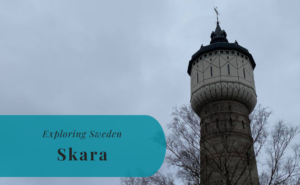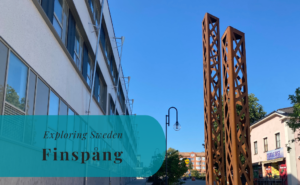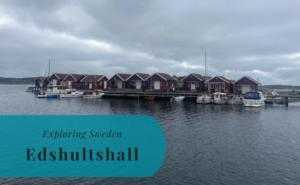The last residence of Alfred Nobel and the home of the defense giant Bofors, this is Karlskoga. Today the town is a part of Örebro County, but once upon a time, it was a parish on the border between the provinces of Närke and Värmland.



A Short History of Karlskoga
The parish of Karlskoga was established in 1586 with a wooden church at its center. It was at the time placed in the borderlands between the provinces of Närke and Värmland, forcing an adjustment of the border so that the whole parish became a part of Värmland. It was after a visit in 1589 by the soon-to-be King Karl IX that the name Karlskoga was chosen for the parish. The name means Karl’s Woods.
Mining and Ironworks
The 1630s saw the start of iron production in Karlskoga Parish. The area already had mines for iron ore and now several ironworks, trip hammers, factories were established to refine the ore. The factories around the homestead Boo expanded a lot during the 19th century. Production eventually included axes, shovels, horseshoes, and nails and it was the start of what was to become the company Bofors. Towards the end of the 19th century, the company started the production of canons, something that turned out to be the start of the military production that Bofors has become famous for. The inventor Alfred Nobel acquired Bofors in the 1890s, starting a new chapter in Karlskoga’s history.
Alfred Nobel
Alfred Nobel was born in Stockholm in 1833 and became one of the most famous inventors in the world. Nobel is the father of dynamite, which he patented in 1867. Nobel lived a few years in Karlskoga after his acquisition of Bofors. He left Sweden and moved to Paris a short time before his death in 1896. This would eventually lead to a battle about which country’s courts would make the final decision about his will. It was eventually the court in Karlskoga that got the honor and set the gears in motion for what was to become the Nobel Foundation in 1900. The foundation has since 1901 awarded the Nobel Prize in Physics, Chemistry, Medicine, and Literature.
Bofors
In the early 20th century Bofors was the sole Swedish producer of canons and the 1910s saw an increased export of canons for battleships. The activities in Karlskoga and at Bofors would afterward mostly follow the stability of peace in Europe. The population of Karlskoga reached its peak around 1970 when the population almost reached 40.000. Bofors was at the time the largest employer by a big margin, with around 10.000 employees. Bofors survived until 1991 when it was merged with Förenade Fabriksverken. The company w<z in 1999 be acquired by Saab Group and split up. Bofors Defence is today a part of BAE Systems Ltd and goes under the name BAE Systems Bofors. Then there is Saab Dynamics, Bofors Missiles, and Bofors Carl Gustaf that was merged into Saab Bofors Dynamics and are still a part of Saab Group.



Things to Do and See in Karlskoga
It is no surprise that many of the sights in and around Karlskoga have a connection with Nobel and Bofors. After all, this is the land of the canon.
Nobel Museum & Björkborn Manor
Björkborn Manor was completed in 1814 and housed the owner of Björkborn Ironworks. It became the home of Alfred Nobel in 1894 and acted as his last Swedish residence.
The manor is today home to the Nobel Museum telling the story of the inventor and the Nobel Prize. The exhibitions include the laboratory of Alfred Nobel that was in use during his time at the manor.
The manor also includes the Bofors Industrial Museum in one of its stables.
Rävåskullen’s Canon
One of the largest canons ever produced at Bofors can be found on the hill known as Rävåskullen. The canon was once one of four canons on the Swedish coastal defense ship HSwMS Sverige. The ship was launched in 1915 and scrapped in 1958, at which point one of its canons was given to Karlskoga municipality.
Karlskoga Hembygdsgård
Karlskoga Hembygdsgård, the home of the local heritage organization, is housed in a homestead known as Bergsmansgården in the area of Aggerud. The homestead has a history dating back centuries and is today the location of a few buildings from the past.
Karlskoga Sports Museum
The Local Sports Museum is run by Karlskoga Sports History Society. The group meets according to their homepage once per week and has collected a lot of photos and objects from the area’s sports teams.
BIK Karlskoga and Nobelhallen
BIK Karlskoga is the local ice hockey team and they are currently housing in the second tier league in Sweden – Hockeyallsvenskan. The team was founded in 1963 and was from 1979 to 2011 known as Bofors IK. They have played a total of 16 seasons in the top division, most of these seasons were played by IFK Bofors, a predecessor to the current team, and the last time BIK Karlskoga played in the top division was in 1975.
BIK Karlskoga plays their home games in Nobelhallen, an arena built in 1972 and that can take 5.600 spectators (20th most in Sweden for Ice Hockey). Most of the capacity is for standing spectators, with only 1.266 seats.
Ekmansdalen Park
Ekmansdalen is a park right next to the center of Karlskoga. It follows a small stream shaded by the many trees.
Nobel Park
The Nobel Park, Nobelparken in Swedish, is in the vicinity of Björkborn Manor and is a strip of fields pointing in the direction of the manor.
Courthouse Park
The Courthouse Park, or Tingshusparken, is close to the church, and today it houses an art gallery. Next to the art gallery, there was once a courthouse in which the testimony of Alfred Nobel was confirmed. You will also find a bronze statue of the famous inventor here.
Torkesviken Nature Reserve
Torkesviken Nature Reserve is located to the northeast of the center and was established in 2002. It covers an area of around 48 hectares and here you will find several trails for walking and running.
Bullerdalen Nature Reserve
Also in the northeast of the town, there is Bullerdalen Nature Reserve established in 2000. This nature reserve covers an area of 31 hectares and includes several walking paths along the river Svartälven.





How to Get to Karlskoga
- Flights: Closest airports are Örebro Airport (ORB), 36 kilometers away, and Karlstad Airport (KSD), 82 kilometers away. Both of these has mostly charter and domestic flights. In addition, there is Stockholm-Arlanda Airport, 247 kilometers away with international flights.
- Car: Karlskoga is along road E18 between Kristinehamn and Örebro.
- Bus: Local and regional buses from Länstrafiken Örebro connect Karlskoga with the surrounding region.
- Train: Closest railway station is in Degerfors, 19 kilometers to the south. From here SJ and Länståg have departures to and arrivals from several towns in Sweden, including Arvika, Charlottenberg, Karlstad, and Stockholm.
The driving distance from 5 major Swedish cities, according to Google Maps:
- Stockholm – 236 kilometers (2h 43min)
- Gothenburg – 273 kilometers (3h 32min)
- Malmö – 540 kilometers (5h 57min)
- Linköping – 158 kilometers (2h 10min)
- Kiruna – 1343 kilometers (15h 43min)
Find out more about other destinations in Sweden by visiting our page Exploring Sweden






